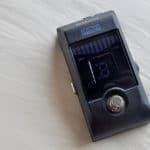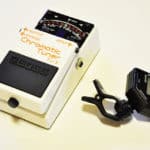Have you ever thought about if cutting your guitar strings is the right thing to do?
Are you cutting them right?
What are the risks or benefits of doing so in that way?
There are many things guitar players take for granted, and there’s nothing wrong with being curious about why things are the way they are.
So, should you cut your guitar strings?
It’s customary to cut guitar strings after they go through the tuner. This allows for an easier wind-down and prevents poking your fingers with their sharp ends. You can do this with a wire cutter. To know where to cut just put them in place and clip them with 2 tuner lengths of slack.
In this article, I will tell you all you need to know about why cutting the strings of your guitar is a good idea, and how you should do it.
After leaving this page, you will know exactly when to cut your strings and when it’s better to leave them as they are.
Also, we will talk about a special case in which you will need to cut the ball ends of your strings.
Are you ready to get started?
Let’s go!
Is there any advantage to not cutting your guitar strings?
Guitar strings come in a length that’s longer than what you really need on your guitar.
Cutting them is natural, and helps to maintain a tidy look on your instrument, so as to prevent their sharp ends from cutting your fingers when you reach for the tuners.
However, trimming the end of your strings is not mandatory, since it has no real impact on how the instrument performs.
A possible advantage of not snapping the exceeding part of your strings before restringing your guitar is to prevent cutting them too short and not being able to wind them properly at the machine heads.
Now, if we are talking about cutting your strings when they are old and you need to replace them, I’d advise against it, more on this later.
Why should you cut your string’s ends?
New guitar strings are longer than required to be used.
However, manufacturers give you some slack because there are many different guitar scale lengths and different ways of winding them in place.
You can always cut a longer string, but can’t do anything with a shorter one. This is why you should always cut your strings after you put them in place and not before.
We all have messed this up at some point in our guitar journey.
When you install your strings, it’s common to cut the excess bits after the tuners.
Doing this gives a tidier look to your instrument and prevents you from stinging your finger with those sharp string ends when you reach out to tune your instrument.
Guitars with Floyd Rose tremolo systems require not only for you to cut the ends of strings but to also trim the ball stoppers that usually hold them in place at the bridge.
This kind of bridge has a unique way of clamping the strings at the saddles where ball ends don’t fit.
What is the best way to clip your guitar strings?
Just about any simple wire cutter will be enough to trim your guitar strings once they are in place.
Some players prefer to wind the strings down and then cut the slack.
However, winding down on the tuners might get a bit hard with that much excess string.
A wiser method is to just put your strings through the bridge or guitar body (depending on how your guitar works) and then run them straight along the neck as they should go once tight, get them past the machine head, and cut them where the next or second next tuner ends.
This will leave you with some excess length to wind down the pole as you should, but not that much to make this task extremely cumbersome.
With practice, you will end up having a better feel for how much extra string you need for a proper fit.
Finally, just to clarify, everything I said here about winding down the strings at the tuners refers to traditional tuners.
For locking tuners there’s no need to wind strings down, and you can cut them just as they come out from the groove, once they are locked in place.
Is it ok to cut your strings when replacing them?
I have seen a lot of guitarists, and even techs just cut old strings in the middle when replacing them, and it always worries me a bit.
To be honest, this is probably the gear over protector in my, but I will lay out my case:
Strings on a guitar pull with great tension from the tuner to the bridge, and I believe releasing this tension suddenly might lead to undesired outcomes.
Is this scenario likely? Not at all, guitars are tougher than we think.
However, why risk it?
I prefer to always loosen my strings gradually, one by one, and then remove them.
Sometimes it’s faster to cut the section that was winded on the tuner since it gets deformed and stuck when passing through the nut, bridge, and/or body, but that’s as much as I normally cut.
Again, this is probably an overkill, but I see no point in rushing the process.
Can cutting your strings damage your guitar?
Cutting your strings when they are holding tension is unlikely to damage your guitar, however, it can’t be good for it anyway.
The snapping string can whip and hurt you or chip the paint somewhere.
Also, the neck might adjust abruptly to the new lower tension, and although it’s very unlikely for it to be damaged, I don’t think mistreating it is a good idea long term.
In my opinion, it’s best to loosen your strings before removing them, so you give some time to your guitar to stabilize.
And if you are wondering, there’s no problem in leaving your guitar with one or more missing strings for a while.

Hello there, my name is Ramiro and I’ve been playing guitar for almost 20 years. I’m obsessed with everything gear-related and I thought it might be worth sharing it. From guitars, pedals, amps, and synths to studio gear and production tips, I hope you find what I post here useful, and I’ll try my best to keep it entertaining also.





